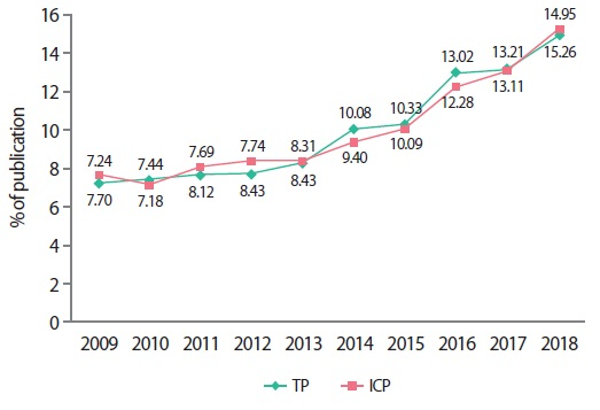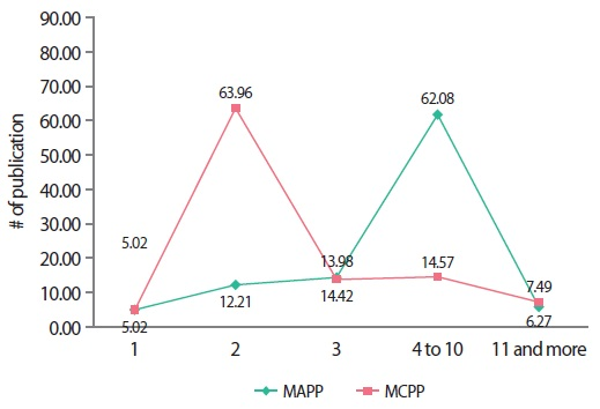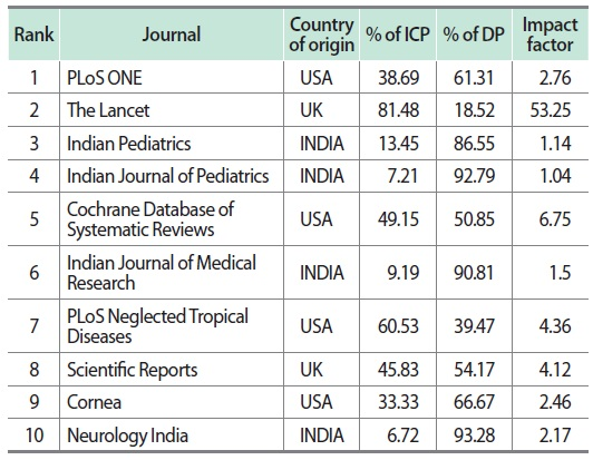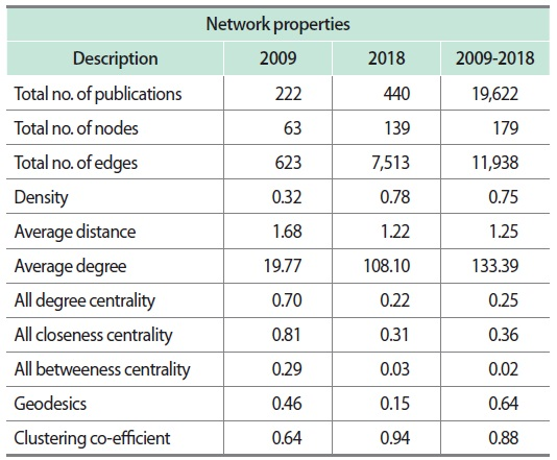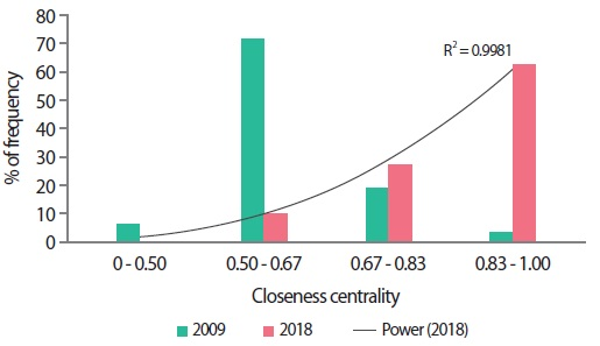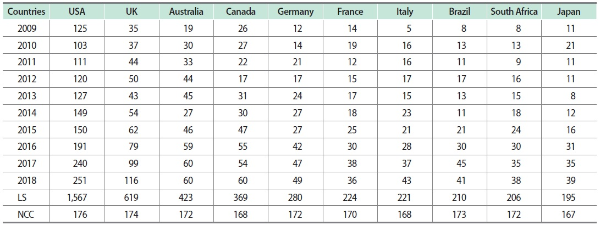ISSN : 2287-9099
A Scientometric Social Network Analysis of International Collaborative Publications of All India Institute of Medical Sciences, India

R. Jeyshankar (Department of Library and Information Science, Alagappa University)

Abstract
Scientometrics and social network analysis (SNA) measures were used to analyze the international scientific collaboration (ISC) of All India Institute of Medical Sciences (AIIMS) for a period of 10 years (2009-2018). The dataset consists of 19,622 records retrieved from the Scopus database. The mean degree of collaboration 0.95 implied that researchers of AIIMS tend to collaborate domestically (80.29%) and internationally (14.67%). The data exhibits a hyper authorship pattern, and a medium-size research team consists of 4 to 10 authors who contributed a maximum of 62.08% (12,182) publications. 71.97% of research findings are scattered in journal articles. The most preferred journals published 58.55% of medical literature. An undirected collaboration network is constructed in Pajek to study the ISC of AIIMS during the period 2009-2018 which consists of 179 vertices (Vn) and 11,938 edges. The degree centrality (Dc) identified that the United States of America (Dc - 54; CC - 0.99) and United Kingdom (Dc - 41; 0.98) are the most collaborative countries in the whole network as well as the most influential countries. The Louvain community detection method is used to detect influential research groups of AIIMS. The temporal evolution of ISC of AIIMS studied through scientometrics and SNA measures shed light on the structure and properties of ISC networks of AIIMS. It revealed that AIIMS, India has taken keen steps to enrich the quality of research by extending and encouraging the collaboration between institutions and industries at the international level.
- keywords
- All India Institute of Medical Sciences, scientometrics, social network analysis, centrality measures, community detection, international scientific collaboration
1. INTRODUCTION
The All India Institute of Medical Sciences (AIIMS) is a group of medical educational institutions established by an Act of Parliament to serve as a nucleus for nurturing excellence in all aspects of healthcare. AIIMS, New Delhi is the forerunner of the medical educational institution since 1956.
Under the Pradhan Mantri Swasthya Suraksha Yojana scheme during the year 2012, six new AIIMS were started in the under-served places of Patna, Bhopal, Raipur, Bhubaneshwar, Jodhpur, and Rishikesh with the objectives of correcting regional imbalances in the availability of affordable and reliable tertiary healthcare services, augmenting facilities for quality medical education, creating a critical mass of doctors, and conducting research in the country relevant to the area. AIIMS is recognized as an Institute of National Importance by the Government of India.
In addition to the seven AIIMS institutions, four more AIIMS were started during 2018 at Raebareli, Nagpur, Mangalagiri, Gorakpur, and Bathinda. AIIMS offers educational programs in medical and paramedical courses at undergraduate and postgraduate levels, clinical services through hospitals, and specialty centers across India. AIIMS researches common diseases, prevention, and treatment of national health problems.
There is a common assumption that published literature is the output of the research activities of an institution that helps to evaluate the quality of education and clinical care. Many studies have analyzed the research publication of AIIMS from a different perspective. Nevertheless, none of them have analyzed the research productivity of AIIMS from the perspectives of scientometrics and social network analysis (SNA) and attempted to visualize the international scientific collaboration (ISC) of AIIMS.
This study aims to exploit scientometrics and SNA measures to the data set of publications by the AIIMS. Scientometrics were utilized to measure the growth of internationally collaborative publications and their mode of communication, collaborative, and authorship pattern. This measure also tried to rank the journals in which most ISC articles appeared along with their impact factors. Whereas SNA illuminates the centre-periphery relationship processes of information sharing and information diffusions, and dynamics of collaboration network structure, it also intends to identify the most collaborative, influential, and intermediary countries in the collaborative network of AIIMS. It tries to explore the communities and their network properties of the ISC network of AIIMS.
2. LITERATURE REVIEW
There are cumbersome research works that are already carried out on ISC starting from the nineteenth century, and criteria for collaboration are also analyzed to a great extent (Beaver, 2000; Beaver & Rosen, 1978). The research publication of ISC and the number of countries entered into collaboration has also increased tremendously during the last 20 years (Bornmann, Wagner, & Leydesdorff, 2015). The application of scientometrics measures to all disciplines from science to social science is studied for international collaboration (IC) in all aspects. The common method of quantifying the collaborative trend among countries is analysis of the co-authorship pattern (Newman, 2004). Absolute and relative measures are used to determine IC links and strengths among countries in science and social science (Luukkonen, Tijssen, Persson, & Sivertsen, 1993). The impact of ISC is evaluated by the indicators mean objective citation rate, normalized mean citation rate, and fixed expected citation rate (Gal, Glänzel, & Sipido, 2017).
Besides this, SNA offers measures to analyze the structure of collaboration networks, to identify the most influential, intermediary, and powerful nation, and to visualize the collaborative pattern, information flow and diffusion, and scientific community of authors. SNA is used in scientometrics to answer queries of the national policy user (Noyons, 2005). SNA is widely used to construct the ISC networks for disciplines including mathematics and neuroscience (Barabási et al., 2002); science (Leydesdorff & Wagner, 2008; Wagner & Leydesdorff, 2005; Wagner, Park, & Leydesdorff, 2015); physics, biomedical research, and computer science (Newman, 2001); and interdisciplinary fields such as geographic information science (Sun & Manson, 2011), in order to study about the evolution of ISC networks over some time, to identify the communities of scientists in the subject fields, to determine the strength and weakness of the research fields, and to distinguish research groups and communication behaviors of scientists. SNA is also employed to understand the international linkages between countries (Wagnar et al., 2015), knowledge flow among two countries (China and European Union member states) (Wang, Wang, & Philipsen, 2017), and to recognize the availability of research resources and infrastructures within a nation (Gazni, Sugimoto, & Didegah, 2012; Mena-Chalco, Digiampietri, Lopes, & Cesar, 2014).
The research productivity of AIIMS is already analysed statistically, by Jeyshankar and Nishavathi (2018) who evinced the exponential growth of publication and predicted the growth trend. But this article approaches the research publication of AIIMS from two aspects, scientometrics and SNA. It analyses the ISC of AIIMS by the construction of networks to uncover the expertized knowledge flow between AIIMS and foreign countries, to explore the evolution of the ISC network throughout the study, and to recognize the communities of specialists and their linkages. The outcome of this research work will help administrators and policymakers for sanctioning funds and developing infrastructure facilities. It also helps the authors of AIIMS to know the communities of scientists in their respective research fields and the availability of research resources in other countries.
3. METHODOLOGY
In this study the data set represents the ten-year publication output of AIIMS faculties and their collaborators, which are retrieved from the Scopus database. During the years 2009-2018 additionally 11 AIIMS across the country started functioning in India. Hence the ten years are selected for the study. In this article AIIMS represents the totality of publication output of 11 AIIMS medical institutions. The search term “All India Institute of Medical Sciences” and “AIIMS” are used in the authors’ affiliation field. In total 19,622 bibliographical records are retrieved from Scopus and downloaded in.ris file format.
Bibexcel (Persson, Danell, & Wiborg Schneider, 2009) is an open source bibliometric tool used to check duplication of records, standardization of name of authors and addresses, to calculate frequency distribution, to analysis the authorship pattern, and to generate network files, which are further exported to Pajek to analyse and visualize the network structure and properties of the international scientific collaborating pattern of AIIMS. Microsoft Excel is used for further standardization of addresses and descriptive statistical analysis of the data set.
Bibexcel identified 612 documents lacking address fields that are again verified with the corresponding document number in the.ris file format to retrieve the addresses. The co-occurrence between countries and cluster pairs are created using Bibexcel. The required network files are also generated in Bibexcel.
Normally two methods of attributing publications to collaborating countries are available such as integer (Luukkonen et al., 1993), whole count (Zitt, Bassecoulard, & Okubo, 2000), fractional, and link methods. In this article, the whole count method is used in calculating the productivity of the collaborating countries. Single authorship denotes that the research was carried out and published by an author (sole authorship). On the contrary, multiple authorship exhibits the multiple relationships between countries in publishing an article that is counted as a single link strength. If an article has 9 international addresses from 6 countries (A, B, C, D, E, F) the productivity of collaborating countries is calculated as 1 for each collaborating country (not A=2, B=3, C=1, D=1, E=1, and F=1). Similarly, link strength between collaborating countries is also counted, hence normalization of links is not carried out in this research. The term “strength” is used in this article to mean activity in IC between countries (Luukkonen et al., 1993).
In total 2,883 documents in which an author from AIIMS collaborated with at least one other author affiliated from a country other than India are extracted from the data set. This data set is used to construct the network of the ISC of AIIMS. The networks are constructed for ISC of AIIMS where nodes represent the country; links between the nodes indicate collaboration between countries in producing an article. The size of the links is determined by the number of times a country collaborated with the same country during a particular period. Similarly, the size of the nodes is determined by the number of collaborating countries involved in publishing an article.
Three networks are constructed to visualize the structure and pattern of ISC of AIIMS at two different windows for the years 2009 and 2018, which enables us to study the evolution of the collaborative pattern of AIIMS. The global, as well as local SNA measures, are used to study the network structures of all three networks.
The energy command in Pajek, Kamada and Kawai (1989), and Fruchterman and Reingold (1991) are used to visualize the networks.
4. DATA ANALYSIS
4.1. Application of Scientometrics Measures to the Research Output of AIIMS
Fig. 1 exhibits the annual growth of publication along with the international collaborative publication (ICP) of AIIMS. The annual medical literature increased constantly in polynomial distribution during the study period. During the years 2009-2013 the percentage of average productivity observed is 7.68, increasing to 12.32 from the years 2014 to 2018. The year 2018 is identified as the most productive year with 14.95% of cumulative output. AIIMS is keen to publish articles in collaboration with other nations. Except for the year 2010, internationally co-authored publications increased constantly. During the years 2009 to 2013 the growth percentage of ICP is slightly higher than the percentage of total publication (TP - 7.7, ICP - 7.9), but in the second block period it is changed vice versa (TP - 12.31, ICP - 12.01).
4.2. Collaborative Pattern
The study evinced a 0.95 mean value of degree of collaboration which implies that authors from AIIMS tend to collaborate domestically (80.29%) rather than internationally (14.67%). 2,883 documents are published by AIIMS in collaboration with authors from 179 countries. Domestic collaboration (DC) is five times greater than IC. 5.04% of publications are contributed by single authors with oscillated productivity during the study period. Fig. 2 illustrates that an increase in productivity resulted in a proportionate increase in domestic as well as IC. In 2018 the productivity reached the maximum of 2,933 publications with a maximum level of collaboration (DC =440, IC=440).
Fig. 2.
Collaborative pattern of All India Institute of Medical Sciences. IC, international collaboration; DC, domestic collaboration; SA, single author.
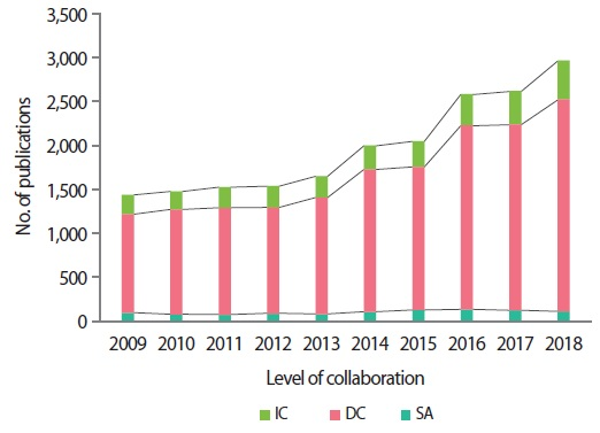
Fig. 3 supplements the tendency of AIIMS towards collaboration as exhibited in Fig. 2. A medium-size research team consists of 4 to 10 authors contributing a maximum of 62.08% (12,182) publications. 12.21% (2,395) accounted for two authored publications, and 7.49% (1,230) of publications are published by large research teams (11 and more), which is higher than for sole author publications. On the contrary, two-country publications attained a maximum of 63.96% and a minimum of 14.57% publications were contributed by the collaboration of 4 to 10 countries. The percentage of three authored and three country collaborated publications is more or less the same (14.42%, 13.98%). The average (5.02%) of a single author and country publications are the same as they affiliated to AIIMS, India.
4.3. Communication Pattern
Table 1 tries to analyze the communication pattern of internationally collaborated publications of AIIMS. The present system of basic research in the sciences and scientific communications depends almost entirely on the primary journal literature (Van Raan, 2004). Accordingly, 71.97% of research findings are scattered in journal articles followed by reviews and letters (4.75%). 45.68% of articles are published by AIIMS in unilateral collaboration (AIIMS collaboration with a country), which is relatively higher than for bilateral (13.97%) and multilateral (22.06%) collaborative articles. Unilateral and multilateral collaboration was predominantly identified in all sources of communication except short surveys. There is a meager amount of collaboration (unilateral - 4, 8; bilateral - 2, 3) found in publishing books and articles in press. There is no multilateral collaboration identified in publishing books.
4.4. Most Preferred Journals for International Collaborative Publication
Table 2 describes the journals that published internationally collaborative literature of AIIMS, ranked according to productivity. The impact factor for the journals is derived from Incites Journal Citation Report by Clarivate Analytics. In total 19,622 medical literature publications were published in 3,138 journals amongst 40.88% (1,283) of journals published internationally collaborative medical literature, and 59.12% (1,855) of journals published single articles. The most preferred journals published 58.55% of medical literature and 11.88% of internationally collaborative literature. PLoS ONE (77) is the most preferred journal, publishing 38.69% of ICP and 61.31% of domestic publication (DP), followed by the highest impact factor journal The Lancet (66), which published the highest percentage of ICP (81.48). Cochrane Database of Systematic Reviews (29) is the second-highest impact factor journal in which 49.15% of ICP and 50.85% of DP are published by AIIMS. AIIMS predominantly contributed domestic articles in Neurology India (16), Indian Journal of Pediatrics (30), and Indian Journal of Medical Research (26) at the percentages of 93.28, 92.79, and 90.81 respectively. It is noteworthy that PLoS ONE, Scientific Reports (22), and Cornea (17) with origins of United States of America (USA) and United Kingdom (UK) published a higher percentage of DP (61.31, 54.17, and 66.67) than ICP.
4.5. Application of SNA Measures to the Research Output of AIIMS
SNA views the ties or linkages between two or more persons, groups, or institutions as the essential units of analysis (Wellman & Wetherell, 1996). SNA offers quantitative methods and models to study the network structure, and analyse the linkages between nodes and position of the nodes in the network. This study applied some of the most commonly used metrics of SNA to analyze and visualize the ISC of AIIMS. An undirected collaboration network was constructed in Pajek to study the ISC of AIIMS during the years 2009-2018 which consists of 179 vertices (Vn) and 11,938 edges (Fig. 4). Over the period new countries entering collaboration with AIIMS, India resulted in a change of network structure and measures. Hence the study constructed two time window period networks for comparing the network properties for the years 2009 and 2018. Thus the evolution of collaborative networks is also studied in this article.
Fig. 4.
International scientific collaboration network of All India Institute of Medical Sciences during the years 2009-2018 (cluster view).
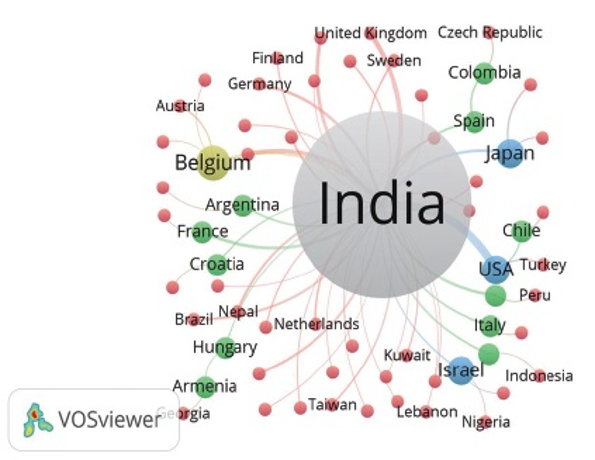
The total number of countries in collaboration with AIIMS doubled in the year 2018 from 63 to 139 and AIIMS extended its research collaboration to 116 more countries during the study period. It is observed from Table 3 that growth of linkages between the countries is fit into logarithmic growth (R2=0.99) rather than linear (R2=0.98).
4.6. Density
The density of a graph is quantitatively defined as the number of links divided by the number of vertices in a complete graph with the same number of nodes. It is an indicator of the general level of connectedness of the graph (Zhang, 2010). The density for the whole ISC network (Fig. 4) indicates that 75% of countries in the network collaborate with each other. When the density of the network is compared, ISC 2018 network (Table 3) is a complete network in which 78% of countries are connected directly to each other country. It reveals that AIIMS has collaborated well in research activities among the countries.
4.7. Average Distance
Average distance is the distance between two nodes in the shortest path connecting them in the network. The average distance of the ISC network 2009-2018 implied that countries in the network needed only 1.25 steps to reach each other (Fig. 4). The average distance between the nodes is low (1.22), therefore the network for the year 2018 is dense (Table 3). Similarly in the year 2009 the low density (0.32) of the network resulted in a high average distance (1.68). There are no unreachable pairs of countries in the networks. The most distant countries are the USA and United Arab Emirates (distance – 2) in the 2009 network (Fig. 5). Again USA and Belarus are identified as the most distant countries in the 2018 network (Fig. 6).
4.8. Average Degree
Degree of countries is the number of countries having collaboration with other countries. The average degree of all countries in the network is used to measure the structural cohesion of ISC networks (Table 3). The average degree of the ISC network is grown from 19.77 to 108.10, and the whole network 2009-2018 has a high average degree of 133.39.
4.9. Geodesics
In simple terms, this is the shortest path between the two countries in the ISC network. The geodesic for the ISC network 2009-2018 is 0.64, which is the shortest path through the network from one country to another. The geodesic for the ISC network of 2018 is reduced drastically from 0.46 to 0.15 (Table 3). It indicates the completeness of the network.
4.10. Clustering Co-efficient
The clustering co-efficient (C) is computed for three window periods of global networks (2009, 2018, and 2009-2018). C is derived by the mean probability of collaboration of two countries in the network that are in collaboration with the same country. Such clustering takes the shape of triangles. For example, in Fig. 5, collaborators of the country Chile are Finland and Ireland, that collaborated with each other and formed a triangle of collaboration. C for the year 2018 increased from 0.64 to 0.94. Table 3 implies that there is a high chance for collaborating countries of AIIMS to collaborate among themselves. It always takes the non-zero value (Newman, 2001).
4.11. Centrality Measures
Centrality is one of the most studied concepts in SNA (Borgatti, 2005). Centrality measures are used to determine the relative importance of a node within the network. This measure can be applied to an individual vertex, or a group may be an organization or a group of ethnical people to find out the most central and influential individual or group. It is a relative measure with values between 0 and 1 (Otte & Rousseau, 2002). In this study the three basic centrality measures of degree, closeness, and betweenness are applied to the ISC network to identify the most influential and intermediary countries who collaborated with AIIMS.
4.12. Degree Centrality
The size of the vertices is determined by its degree centrality (Dc), which is equal to the number of collaborators it has (co-author, country, or institution) in the collaborative network. All Dc of a network indicates the average degree of all vertices in the network. AIIMS collaborated with 178 countries (Dc - 178) followed by USA (Dc - 176) and UK (Dc - 174). All Dc for the years 2009-2018 is 0.25, indicating that countries are well connected in the network (Table 3). In the year 2009 the USA secured the second-highest Dc (54) followed by UK (41). These two countries consistently occupied second and third place in the year 2018 also (USA - 134, UK - 130). Over the years, the Dc of countries has changed. In Fig. 5 Brazil collaborated with 38 countries and ranked in fourth place during 2009. In the year 2018 its collaboration increased to 128 and it ranked in fifth position. This is mainly due to the increased collaborative link of Belgium (130) and Bangladesh (129) with AIIMS in the consequent years. But in the overall period of network Brazil again occupied fourth position. The Dc for the year 2009 is 0.70, which is highest compared to 2018 (Table 3). The emergence of new countries in collaboration with AIIMS and increased collaborative links among countries reduced the Dc for the year 2018 to 0.22.
4.13. Closeness Centrality
Closeness centrality (CC) is used to identify the most influential person in the network. It is computed by short geodesic distances between one vertex to all other vertices within the network, which gives higher value to the most central vertex. It also measures indirect collaboration among countries in the network. The CC for the whole network (2009-2018) is 0.36 (Table 3) and AIIMS secured the maximum value of CC - 1 followed by USA (CC - 0.99) and UK (CC - 0.98), which implied these countries have collaborated with all other countries through short paths. In the year 2009, 3.17% of countries are most influential and centrally located in the network (Table 4). But the percentage of most influential countries increased tremendously to 62.58% in 2018, inferring that countries like Belgium (CC - 0.94), Bangladesh, and Singapore (CC - 0.93) have started to collaborate more, as high CC was positively associated with their Dc and increased size of the network. It is noteworthy from Fig. 7 that CC for the year 2018 fits it to the power-law phenomenon of R2=0.99. All close centrality for the year 2018 is lesser than for 2009 (CC 0.81>0.36), which indicates the positive correlation between degree and closeness centralities (Table 3).
4.14. Betweenness Centrality
Betweenness centrality (Bc) measures the extent to which a particular country lies between the various other countries in the collaboration network. All Bc for the year 2009-2018 is 0.02 (Table 3). Again AIIMS secured the highest Bc - 0.02, followed by USA (Bc - 0.009) and Germany and UK (Bc - 0.0051), which shows that these countries are playing the role of the middleman by connecting different groups of countries (Otte & Rousseau, 2002). Bc is illustrated in Fig. 4. Australia acts as an intermediary to AIIMS along with groups of countries like Benin, Kazakhstan, and Iceland. Similarly the UK, USA, and Nigeria also play the role of middleman and have the potential to control the flow of information between countries. 41.26% of countries are in the peripheral of the network in the year 2009 (Fig. 5), drastically reduced to 18.70% in the year 2018 (Fig. 6). 1.59% of countries play an intermediary role and are very central to the network in the year 2009 and their betweenness is reduced further to 0.72% in 2018.
4.15. Highly Collaborating Countries: Links and Strengths
Table 6 illustrates the chronological distribution of link and link strength of the top 10 highly collaborating countries with AIIMS. The countries are arranged by their link strength. AIIMS, India collaborated with 178 countries to produce 2,883 medical publications. USA published 54.35% of documents in collaboration with 176 countries followed by the UK (21.47%, NCC – 174). Australia, Germany, and South Africa published 14.67%, 9.71%, and 7.15% of documents, respectively in collaboration with 172 countries. China and Mexico collaborated with 171 countries but are not ranked in the list due to their low link strength (192, 138). Canada collaborated with 168 countries to publish 12.80% of documents, which is higher than Germany (9.71%), France (7.77%), Italy (7.67%), Brazil (7.28%), and South Africa (7.15%). This may be due to the international collaborative pattern of countries. Canada may collaborate more bilaterally than multilaterally hence the number of collaborated countries found is low. This corroborates the prevalence of multilateral IC in documents published in AIIMS, India. When compared with the two time window periods increased link strength is identified among the highly collaborating countries (Fig. 4). The link strength between countries is numbered adjacent to the edges.
4.16. Analysis of Community Detection
The word “community” intuitively means sub-networks whose edges connecting inside of them (intracommunity edges) are denser than the edges connecting outside of them (intercommunity edges) (Murata, 2010). Communities in the ISC network consist of a group of internationally collaborated authors who are more highly collaborative with each other than the rest of the authors in the network. A separate network is created for the internationally co-authored publication of AIIMS with a threshold value of a minimum of 10 publications per author, resulting in 1,252 authors (4% of total no. of authors). The co-authors in the network are paired by clusters for better visualization. Louvain method is used to detect influential research groups from the internationally co-authored network of AIIMS.
Multilevel coarsening and multilevel refinement have been chosen for optimizing the modularity of the network. This reconstructed the network into 34 communities (Fig. 8). The largest community structure is cluster 7 (red color), which covered 24.68% of the co-authored network positioned near to the peripheral of the network, with large numbers of collaborations between major authors; C. J. L. Murray (Cn-101), N. Sharma (Cn-103), J. B. Jonas (Cn-68), and R. Gupta (Cn-68) portray the character of the non-central polar community. Cluster 10 (green color) is the second-largest community, led by N. Sharma, which wrapped 8.23% of the network, followed by cluster 1 (yellow color), led by C. J. L. Murray and covering 8.17% of the network, which is located near to the center of the network.
Fig. 8.
Visualization of communities detected in the internationally co-authored network of All India Institute of Medical Sciences. Communities are differentiated by the color of the vertices.

Table 7 presents the network properties of the top three internationally co-authored communities. Cluster 7 is considered as a low dense network as its connectedness is 0.0065 within the network. But it is recognized as most influential between the communities with higher CC (CC - 0.87) as well as Bc (Bc - 0.99). Hence it transmits and controls the flow of information between other communities. The high Dc (Dc - 0.88) of cluster 7 indicates the members have collaborated with many other authors, which means it is a central community in the whole network. The density of cluster 10 (0.024) is comparatively high which shows that members of the cluster are well connected with each other.
The top three communities are visualized separately for better visualization in Figs. 9-11.
Fig. 9.
Largest community 7 is visualized with Fruchterman–Regingold two-dimension energy algorithms in Pajek. A cluster pair technique is used to generate network files. The size of the node indicates no. of collaborators and edges are weighted by collaborative strength. Vn - 309.

Fig. 10.
Second largest community 10 (The collaborative strength between vertices is denoted by width of the links. Vn - 103 constructed with Kamada-Kawi algorithm in Pajek).
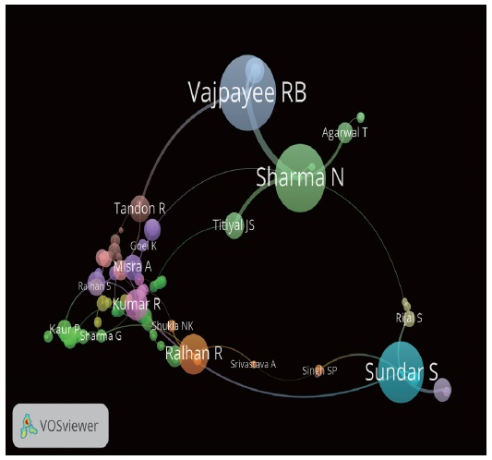
Fig. 11.
The third-largest community 1 (Vn = 101) is visualized with Fruchterman–Regingold two-dimension energy algorithms in Pajek. Cluster pair technique used to generate network files.
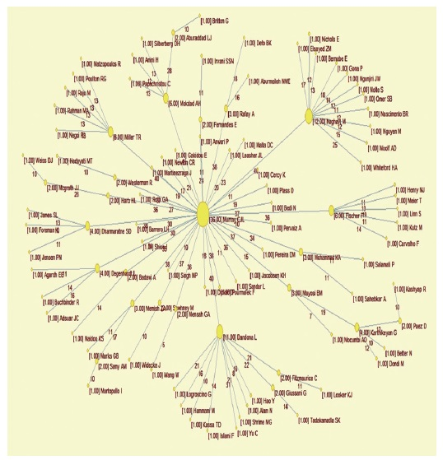
90.61% of authors in the community have a Dc of one and are situated in the peripheral of the network. 9.39% of authors have more connection than others and follow power-law distribution on the collaborative links to authors, which exhibits the features of a scale-free network (Barabási & Bonabeau, 2003). In Fig. 9 M. Moradilakeh has high Dc 270 (0.3%). Moradilakeh’s collaborators, D. C. Schwebel, J. A. Singh, S. S. Lim, and J. Leigh, with highest link strength 38, occupied the center position, referred to as hubs of the network. Centrality measures for this community reveal that M. Moradilakeh is the most productive, influential, and intermediary person in the community (CC=0.88, Bc=0.99), followed by N. Akseer, R. Lalloo, and G. J. Hankey (Bc=0.2), who act as intermediaries between M. Moradilakeh, A. M. N. Renzaho, R. S. Bernstein, P. T. N. Memiah, A. Lafranconi, E. Dubljanin, M. T. Mackay; R. O. Akinyemi, V. Caso, and M. Kravchenko. One can note that Bc for vertices in the peripheral is zero.
The average distance among the reachable authors in the community 10 is 4.92, which implies that most of the authors are connected by short paths. S. Sundar (Dc=11) is identified as a highly collaborative author in cluster 10. 63.1% of authors have higher Cc values ranging from 0.19 to 0.25. 34.9% of authors are in the peripheral of the comparatively low network. 54.3% of authors have the shortest path that passes through a particular author (Bc=0.10). A. Sharma (CC=0.31) is recognized as the most influential author and R. Kumar acts as an intermediary who controls the flow of information role in the network, with high Bc value 0.31. N. Sharma and R. B. Vajpayee co-authored 78 research papers, which are the highest numbers in the community (Fig. 10).
Similar to community 7, 75.24% of authors are found in peripheral positions. The centrality measures of the network unveil C. J. L. Murray as the most active and influential author in the network (Dc=36, CC=0.57, and Bc=0.95) (Fig. 11).
5. FINDINGS AND DISCUSSIONS
This study utilized two indispensable measures, scientometrics and SNA, to the publications of AIIMS to analyze its ISC pattern. Scientometrics measures revealed that the growth of medical literature published by AIIMS increased by polynomial (R2=0.97) during the years 2009-2018. The percentage of average productivity for the block period 2009-2013 is 7.68, increasing to 12.32% in the second block period 2014-2018, which may be due to the increased average number of Ph.D. graduates per faculty (4.4) and average Scopus cited publication per faculty (8). In addition to this AIIMS sanctioned INR 7,000,000/- for research projects per faculty and INR 144,000/-per faculty per year for industrial consultancy during the years 2014-2018.
The previous study (Jeyshankar & Nishavathi, 2018) revealed that the degree of collaboration for AIIMS productivity 0.95 is continued, the same as the present study shows. Experimental clinical trials and epidemiological research are basic procedures in medical research (Röhrig, du Prel, Wachtlin, & Blettner, 2009). Most experimental and clinical trial research requires a more specialized, skilled, and expert person to conduct research. Moreover, the multi-disciplinary and interdisciplinary nature of study proportionately increases the number of collaborators (Nabout et al., 2015); hence the degree of collaboration is consistent over the decades. AIIMS collaborated with 27 countries to publish 973 articles during the years 1959 to 2011 (Wani, Hameed, & Iqbal, 2013) and has tremendously increased to 2,883 publications from 179 collaborative countries, resulting from intra-scientific factors and government support and intergovernmental science programs (Luukkonen et al., 1993).
This study concurs with Cronin’s (2001) findings that several subfields of biomedical research are characterized by a hyper-authorship pattern in which extraordinarily more than hundreds of authors affiliated from dozens of institutions and ten or more countries collaborated to publish an article. AIIMS collaborated with more than a thousand organizations and more than 100 countries to publish 84 research articles. AIIMS collaborated with a maximum of 106 countries twice to publish two articles, 92 countries to produce an erratum, 15 countries to publish an editorial, 85 countries to publish a note, and 14 countries to publish a letter.
The data suggest that collaborative papers are either domestically or internationally published in high impact journals. Domestic publications as well as internationally collaborated publications appeared more in Indian journals than in foreign journals. Hence faculties, scholars, and medical scientists may have more access to Indian journals than foreign journals to publish their research findings.
AIIMS, India attracts sizable grants from national and international agencies. During the year 2017-2018 AIIMS, New Delhi alone conducted 710 research projects worth more than Rupees. 116 crores through extramural research grants (1 crore=ten million rupees). AIIMS has established collaborative links with major countries like the USA, UK, and Australia and international agencies including the World Health Organization (WHO) and United Nations Organization to conduct research work and to enrich the quality of clinical care and medical education. It also extends its research boundaries through intra and inter-organization collaborations. Such collaborative efforts of AIIMS, India is reflected in its ISC networks. The high betweenness value is evident that AIIMS not only collaborated with advanced countries like the USA, UK, and Australia but also acts as an intermediary to enable information flows and knowledge diffusion among under-developed countries like Bangladesh, Armenia, Bulgaria, Singapore, and Uruguay (Fig. 5). These 19 countries occupied a peripheral position with single productivity moved to the central position of the network in the year 2018 (Fig. 6), reducing the betweenness value. During the year 2018, Belarus, Benin, Bhutan, and Bosnia are some of the countries that newly entered into collaboration with AIIMS, which increased the average degree to 108.10 and density to 0.78. It is no wonder that centrality measures revealed that AIIMS, India is the most productive, influential, and intermediary in medical literature published by AIIMS. The high CC value shows that in the near future there may be more probability of collaboration among the collaborative countries of AIIMS. It is noteworthy that due to all CC values, the network is cohesive and there is no unreachable country in the network. Thus, there is no weak component identified by the Pajek.
A separate co-authorship network is constructed to divulge the communities of authors with a threshold value of a minimum of 10 co-authored publications. It resulted in 1,252 authors which constituted the co-authorship network. Louvain method is used to detect communities in the internationally co-authored network. It fragmented the network into 34 strong communities. SNA measures are applied to the strongest three communities, which revealed that authors belonging to each community represent common research problems. For an instant the authors who secured high Dc belonging to community 1 specialize in public health medicine. Examples are: C. J. L. Murray (Dc - 36), affiliated to Dept. of Hlth, Metr. Science, University of Washington; M. Naghavi (Dc - 12), affiliated to Dept. of Hlth, Metr. Science, University of Washington; L. Dandona (Dc - 11), affiliated to the same; and T. R. Miller (Dc - 6), affiliated to Curtin. Univ. Sch., Publ. Hlth., Australia. Similarly the largest community, 7, led by M. Moradilakeh, affiliated to Preventive Med. & Plb. Hlth. Res., Iran Univ. Med. Sci., Iran, is further subdivided into small sub-communities (Fig. 8) led by R. Lalloo (Univ Queensland, Sch Dent, Brisbane, Qld, Australia), G. J. Hankey (Univ Western Australia, Sch Med & Pharmacol, Australia), and N. Akseer (Univ Toronto, Hosp Sick Children, Canada), reflecting that these sub-communities are working around the research interests of the predominant author, M. Moradilakeh. Community detection helps to identify groups of medical scientists based on their affiliation as well as similarities found in their research problems and methodology. It also exhibits the inter and multi-disciplinary research projects of AIIMS.
6. CONCLUSION
The temporal evolution of ISC of AIIMS studied through scientometrics and SNA measures sheds light on the structure and properties of the ISC networks of AIIMS. This study recommends providing more access to foreign journals for the faculties of AIIMS. The authorities may also consider SNA measures to evaluate the research productivity of faculties and to identify research specialties. It revealed that AIIMS, India has taken keen steps to enrich the quality of research by extending and encouraging collaboration between institutions and industries at international level. This study failed to analyze the impact of ISC due to a lack of citation counts for 6,178 records in the dataset. This study does not analyze the impact of inter-organization, inter-sector, and ISC of AIIMS concerning discipline and disease studies. Further research on this perspective will disclose more about the collaborations of AIIMS, which will definitely help in strategic planning and policymaking to redefine its foreign policies concerning ISC.
Application of SNA metrics to the ISC network also helps to identify the most collaborative countries, their fields of study, the pool of subject experts, the scope for research activity, and the availability of research infrastructure facilities in a particular country. It also helps to strengthen the research activity of AIIMS; in turn, the research findings of AIIMS help reduce the disease burden and ensure the wellbeing of the people of India.
References
(All India Institute of Medical Sciences, New Delhi) ((2020), Retrieved February 2, 2019) All India Institute of Medical Sciences, New Delhi (2020). Retrieved February 2, 2019 from www.aiims.edu , from www.aiims.edu
, Beaver, D. deB. (2000, September 1-3). Reflections on scientific collaborations (and its study): Past, present and prospective. In F. Havemann, R. Wagner-Döbler, & H. Kretschmer (Eds.), , Proceedings of the Second Berlin Workshop on Scientometrics and Informetrics, (pp. 29-40). Gesellschaft für Wissenschaftsforschung., , Reflections on scientific collaborations (and its study): Past, present and prospective. In F. Havemann, R. Wagner-Döbler, & H. Kretschmer (Eds.), Proceedings of the Second Berlin Workshop on Scientometrics and Informetrics, 2000, September 1-3, Gesellschaft für Wissenschaftsforschung, 29, 40
Detecting communities in social networks. In B. Furht (Ed.), Handbook of social network technologies and applications () ((2010)) Boston: Springer Murata, T. (2010). Detecting communities in social networks. In B. Furht (Ed.), Handbook of social network technologies and applications (pp. 269-280). Boston: Springer. , pp. 269-280
Science maps within a science policy context. In H. F. Moed, W. Glänzel, & U. Schmoch (Eds.), Handbook of quantitative science and technology research () ((2005)) Dordrecht: Springer Noyons, C. M. (2005). Science maps within a science policy context. In H. F. Moed, W. Glänzel, & U. Schmoch (Eds.), Handbook of quantitative science and technology research (pp. 237-255). Dordrecht: Springer. , pp. 237-255
How to use Bibexcel for various types of bibliometric analysis. In F. Åström, R. Danell, B. Larsen, & J. Schneider (Eds.), Celebrating scholarly communication studies: A festschrift for Olle Persson at his 60th birthday (, , ) ((2009)) Leuven: International Society for Scientometrics and Informetrics Persson, O., Danell, R., & Wiborg Schneider, J. (2009). How to use Bibexcel for various types of bibliometric analysis. In F. Åström, R. Danell, B. Larsen, & J. Schneider (Eds.), Celebrating scholarly communication studies: A festschrift for Olle Persson at his 60th birthday (pp. 9-24). Leuven: International Society for Scientometrics and Informetrics. , pp. 9-24
Measuring science. In H. F. Moed, W. Glänzel, & U. Schmoch (Eds.), Handbook of quantitative science and technology research () ((2004)) Dordrecht: Springer van Raan, A. F. (2004). Measuring science. In H. F. Moed, W. Glänzel, & U. Schmoch (Eds.), Handbook of quantitative science and technology research (pp. 19-50). Dordrecht: Springer. , pp. 19-50
Social network analysis: History, concepts, and research. In B. Furht (Ed.), Handbook of social network technologies and applications () ((2010)) Boston: Springer Zhang, M. (2010). Social network analysis: History, concepts, and research. In B. Furht (Ed.), Handbook of social network technologies and applications (pp. 3-21). Boston: Springer. , pp. 3-21
- Submission Date
- 2019-04-01
- Revised Date
- Accepted Date
- 2020-06-10


